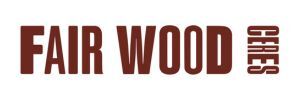News

TMRRW Re:Generator Award: Hey mum, we won!
on Dec 15 2023
Reimagining urban forestry and placing value in waste wood
Logging and clearing of native forests contribute significantly to climate change, driven by the escalating demand for timber. Paradoxically, even with billions spent on importing timber products, thousands of large urban trees across Australia end up in landfills. In Greater Melbourne alone, around 500,000 trees are discarded, releasing CO2 into the atmosphere.
CERES Fair Wood saw an opportunity to reimagine urban trees not as waste but as a valuable timber resource, tackling climate change and fostering a circular economy.
CERES Fair Wood introduced the Urban Forestry Service, challenging traditional forestry practices by bringing the sawmill into the city. Applying Highest and Best Use (HABU) principles, they divert "waste" urban trees from landfills and transform them into ethical timber products. By viewing urban trees as a resource, they aim to reduce carbon emissions from green waste, provide alternatives to timber from native forests, create circular economy jobs, and foster community connection to the urban forest.
Collaborating with research partners, they're defining the city's timber resource scope and exploring a canopy-positive circular economy approach. The project has secured joint ventures, funding from WWF and Sustainable Table, a permanent mill site lease, and infrastructure funding. Their efforts have already diverted substantial carbon emissions and added economic value to finished timber products.
The organisation is committed to changing how society interacts with its timber supply utilising ongoing research, infrastructure development, and strategic partnerships. By challenging the status quo, they're not just building markets for sustainable timber but reshaping the narrative around urban trees, creating a model for other communities to replicate.
Read More about the TMRRW Awards
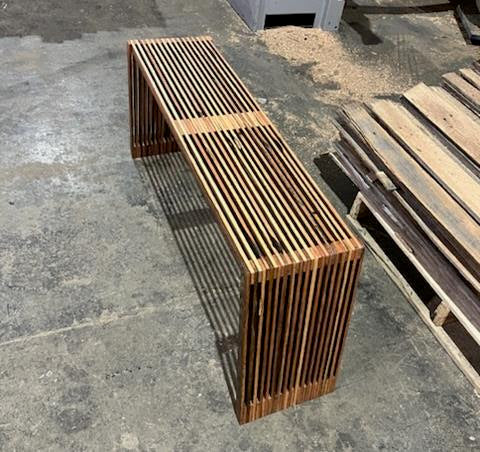
on Sep 04 2023
This blog post is from Chris Ennis' weekly newsletter.
This week in CERES ReBoxCo’s workshop tucked at the rear of Fair Wood’s warehouse, a lyrically named furniture-maker, Floyd Quinlan-Baskett, emerged from his workbench with a brand new bench seat.
With its fine joins and slotted lines Floyd's seat had a delicate Scandinavian spareness that hid its inner strength.
As Floyd brought the new seat out to be put on display it drew oohs of admiration from the Fair Wood sales staff and the carpenters coming in to pick up timber.
Just a few hours later a customer popping in to pick up some other items bought the seat on the spot.
It all happened so quickly that the photo above was the only one Floyd took before his seat disappeared in the back of the customer’s car.
The wonderful secret that many who sit on Floyd’s seat will never know is that it was made entirely from an old hardwood fence destined for the tip.
This is what CERES ReBoxCo is all about - a creative response to timber we throw away when we build or package things.
This has manifested in Floyd’s beautiful bench seats as well as planter boxes, raised garden beds, dog houses, storage boxes, seating pods and café parklets.
Old hardwood fences once dumped into landfill are dropped off by local contractors at ReBoxCo, the palings sanded and oiled back to life will be used as cladding.
More timber is salvaged from end-of-life Macrocarpa windbreaks that were once heaped up into piles and burned.
Pine framing studs that hold together packs of PVC drainage pipes are saved from a neighbouring plumbing supply business who used to throw them in the skip.
Even waste from ReBoxCo’s own furniture-making is repurposed into exquisite trellises.
Recently, a man from Volvo called Lee Amundsen, ReBoxCo’s manager - he was regularly receiving shipments of car parts in new Baltic pine packing crates and he couldn’t stand seeing this beautiful wood being smashed up and thrown away.
This week Lee began using Volvo's Baltic pine to make planter beds.
The great thing about the beds Lee says is the wood is heat, not chemical treated, insects won’t eat it and if the planters are kept above the ground they’ll last 15-20 years.
Now we’re transitioning to living in smaller spaces this is the way we are going to garden.
Instead of sprawling veggie patches more of us grow our tomatoes, greens and herbs in planter boxes and raised garden beds.
Knowing people want not only to garden sustainably but to have their gardens built in the same way, Lee Amundsen has started dotting ReBoxCo’s furniture, planters, raised beds and seating pods in the CERES Nursery and around the park to demonstrate what’s possible.
See ReBoxCo's products here.
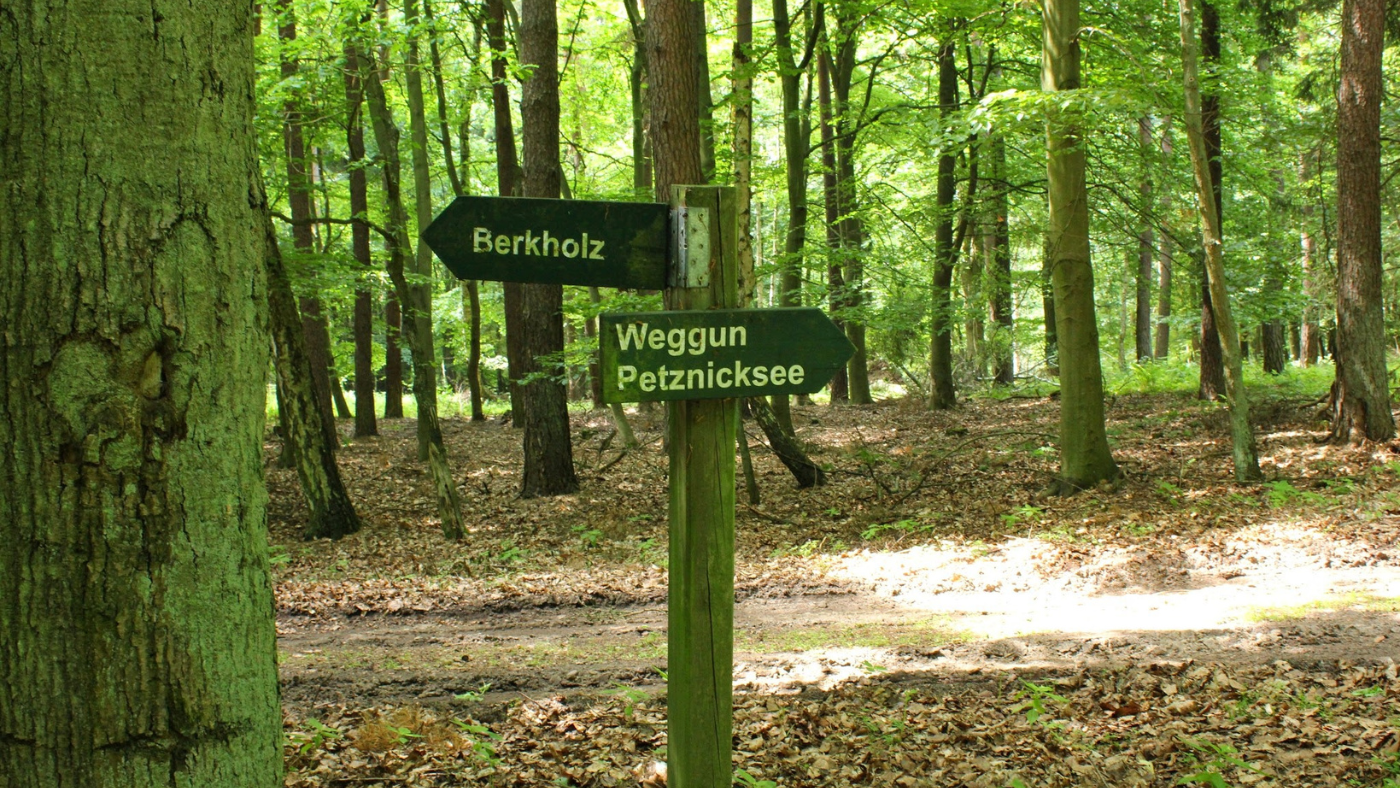
Finding knowledge in the stories of our timber
on Jul 30 2023
On National Tree Day, we find ourselves thinking about the stories of our trees and timber.
Speaking with Ben from Wood4Good, he spent his gap years in Europe and Northern Germany. He relates the story of how once a year people converge in one place and inspect the logs that will go to auction, but its more than just this pure transactional approach, it’s also a social gathering.
They auction the logs one by one and then that night they eat and drink together. The following day buyers organise travel and freight home of their newly bought log. There is value in this exchange, a respect for the fibre but also the cultural traditions, this happens year after year.
These are forests that have been managed by humans for hundreds of years and are a place of recreation, hunting and foraging, they are part of the local culture and lore and their stories ground them to place.
During the lockdown years, CERES ran an online gathering led by Sieta Beckwith our Narrative Director who spoke with Tyson Yunkaporta. Tyson says you can’t have a story without it being anchored in place. This really stuck with me and got me thinking of all the great stories I love and our stories of timber.
It made me realise that the forests of Germany and Ben’s story have this. They are living memories for the people that frequent them anchored in place.
In Australia, we do things differently. There is illegal logging taking place. There are certifications and schemes that are meant to protect our forests, plantations and other sources of wood, but these are often good on paper, but not so good in practice. Under dubious forest practices, we export truckloads of our precious hardwood as woodchips for pulp destined for predominantly cardboard (thanks to international 24-hour shipping windows).
Then we do something even more remarkable, we import millions of dollars of timber, such as old-growth native Baltic pine and south-east Asian rainforest timbers, to build our houses and our furniture. It’s at best a bit topsy turvy, at worst a broken system!
Our added deep-running disconnection we have in so called Australia to identity has thrived off of the nameless and faceless trade of buying and selling ‘sticks’ of timber with no anchor to place and an attitude of 'don’t ask, don’t tell'.
But people are tuning in to being more sustainable in their day-to-day lives, you simply can’t ignore it any longer, the urgency is palpable.
CERES Fair Wood exists to change the way we connect with our timber supply, we are here to celebrate the story of our timber and encourage responsible material selection. We support small-scale farm forestry and the people who champion a better way. We are also always on the look out to extend this network.
In our transparency we are celebrating the story of our timber and of our shared past, to celebrate and take gratitude to the land. We drive that value by stopping and saying, what’s the story here, scaffolding our future timber supply by anchoring it in place and time. Stories can’t exist without place Tyson argues.
Through doing this work, by connecting the dots, people start creating their own connection to place, to the story, to our timber. Where their timber comes from may be a place they will never visit, but bringing the story of that place to them, gives them an opportunity to connect. We begin to understand ourselves within the sense of this living ecosystem. In doing so, we start creating mutual stories of care and respect.
We encourage you to get in touch with us to have a chat about where our timber comes from.
Happy National Tree Day!
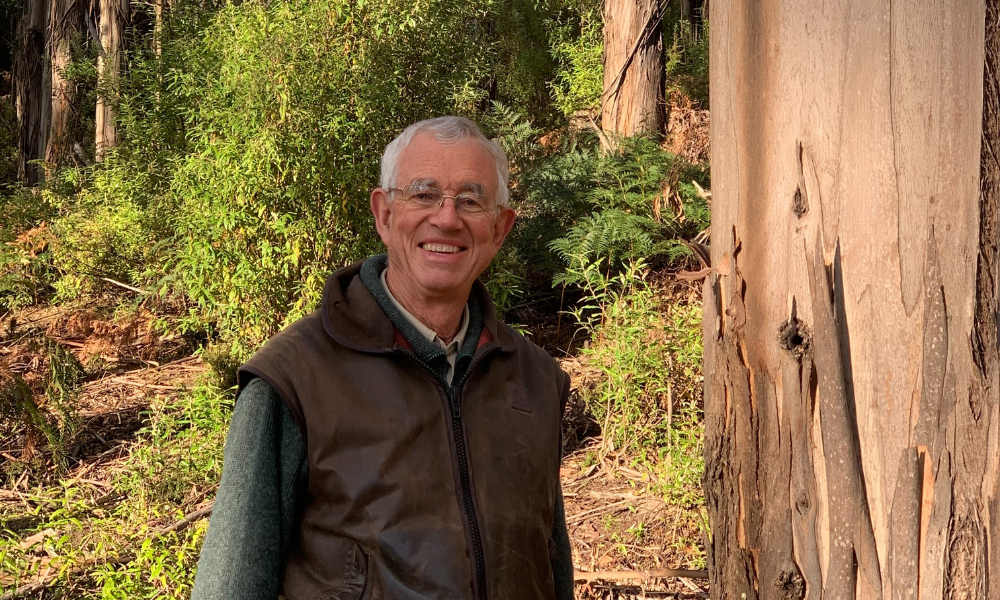
Grower Profiles - John, James and Di Lord of northern lutruwita / Tasmania
on Dec 15 2022
Over 30 years ago, John and Di Lord made the move from the city and purchased approx 760 ha. of mixed forestry and farm land on the Great Western Tiers in northern lutruwita / Tasmania.
Most of the land they purchased had been logged in the early days of the wood chipping industry – meaning clear felling with some seed trees left behind in most areas. These areas have since regrown and are mainly Messmate with some Manna Gum, with the regrowth now about 50 years old.
They also planted out their abandoned farm paddocks with Shining Gum and these paddocks are now teeming with biodiversity and have been thinned over their 30 year lives. The goal with their enterprise is to have a multi-aged Native forest again.
As well as realising their dream to raise their children close to nature and the bush, the land has also hosted many field days and conference tours and has been used for teaching purposes by the University of Tasmania. About 20 years ago, their farm was the site used for the first scientific study into the effect of selective forest management on biodiversity. The scientists found that the active management of the native forested areas as practiced by John and Di resulted in better biodiversity outcomes than in areas that were not managed.
John and Di remain strong advocates for supporting the sustainable development of farmers growing more trees on their land. In 2005 their peers awarded John and Di the Tasmanian Treefarmer of the Year Award and in 2006 they received the National Award.
There have been opportunities in the past to clear fell and sell up their timber to overseas markets for wood chip and pulp but they have resisted this to instead persist in growing their trees to be made into usable sawn timber logs. This is not common in a market that favours this first route and one of many reasons we support their efforts. They are constantly thinking about how to keep value in their local economy.
It is a great privilege for us to have connected with and to expand our timber offering with stock from John and Di’s property. Having worked with the Lord’s now for just over a year it is apparent that they produce great farm forested products. John brings a high level of grading detail and is open to trying new things and working with us.
(Benchtop made using the Shining Gum by Heartwood Building Constructions for NECHHI (Newlands Neighbourhood House in Coburg North, Wurundjeri Country).
We have received a new shipment of Shining Gum joinery in varying dimensions from 90-180 x 12-35, find out more here. We also have internal lining boards in this wonderful timber, find out more here.
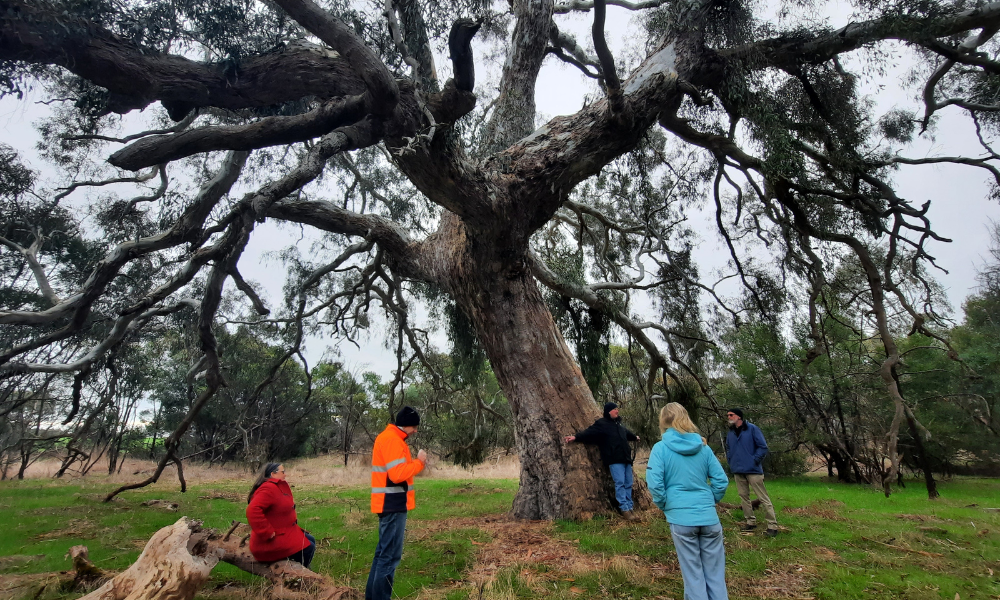
Hayden's trip out west to visit trees of the future
on Aug 04 2022
Building and nourishing our tree connections is everything. In a dwindling timber market, finding people growing trees in the right way and for the right reasons is a daily challenge for our fledgling operation.
A few weeks back Hayden went on a road trip with some people who have been on our journey from the start, miller Rob Horner and co-founder Paul Haar.
They headed West to visit Jigsaw and Mimosa Farms and Arborline Nursery, all leaders in demonstrating, supporting and showcasing the many benefits of growing trees on farms.
While many of the trees Hayden visited aren’t ready yet, we are keen to initiate these conversations early. As the agroforestry and farm forestry movement matures, we are able to offer a direct route to market for these growers and their valuable timber.
Hayden's journal:
"It was an early start on Thursday 2nd of June as I made my way to meet Rob Horner from Yarra Timber Salvage in Lismore (VIC) just as the sun was peeking over the horizon.I was looking forward to spending some time with Rob.
We then drove out together to meet up with the rest of the party in Hamilton at Arborline Nursery. Here we were given a tour of the operations by managing director, Keith Cummings. Keith walked us around the nursery, taking us from the conveyor line where a number of staff are loosening the seedling Southern Blue Gum trees in their tubes for easy removal by those planting in the field. Then moving out into the yard and being overwhelmed with the sheer scale of the nursery. Currently growing in the area of 7 million trees.
After a few hours of walking amongst a sea of seedlings we got in our cars and headed off to Jigsaw Farms, 15 minutes north of Hamilton. Mark Wooten and Eve Kantor have 3500 hectares of farmland and plantations over 2 blocks. As of May 2022, 692 hectares of trees and shrubs have been planted on their land which has seen a number of fantastic results. These include the doubling of food and fibre produced per Ha, being carbon neutral, from 48 species of birds in 1996 to now having 172 species amongst many other benefits both financial and environmental. Arborline Nursery have been working with Jigsaw along the way to get to where they are now. The plantation timbers on Jigsaw farms are not quite ready for harvesting as sawlogs yet but we are very excited for this in the years to come.
Back to Hamilton for dinner and out with all of the touring party then off to bed.
Friday morning we were off again to Mimosa Farm Trees just over the border (SA), 20 minutes south of Mount Gambier. Peter Feast gave us a fantastic tour of his farm and nursery, showing all of the amazing work they have been doing there. Running sheep in and around the plantations of native regeneration and trees planted for their timber. Grabbed a few seedlings on the way out to plant at home on my tiny little plot. Similar to Jigsaw farms we are very excited for the trees being grown for their timber at Mimosa for future harvesting.
The trip helped me appreciate and get a better feel of what actually goes into growing trees through the whole process. From the seedling to getting them into the ground and nurturing them into a harvestable sawlog.
It was great to meet and see the passionate people growing these trees and that growing trees for them goes way beyond the bottom line. For them it is a pursuit of purpose that captures increasing biodiversity on the farm, improving the lives of their animals and aesthetically improving their farms too. It was great to see first hand how these farmers are stewarding their land. I really enjoyed learning about what else is involved in growing trees like waste and creating income streams from thinning to make it financially viable while waiting for the harvest-able logs, which can take years.
These people are really passionate about growing trees on their farm and are keenly invested in ensuring this timber goes on to be used to its highest standard
After visiting Mimosa we were off for a late lunch then a long drive back to Melbourne"
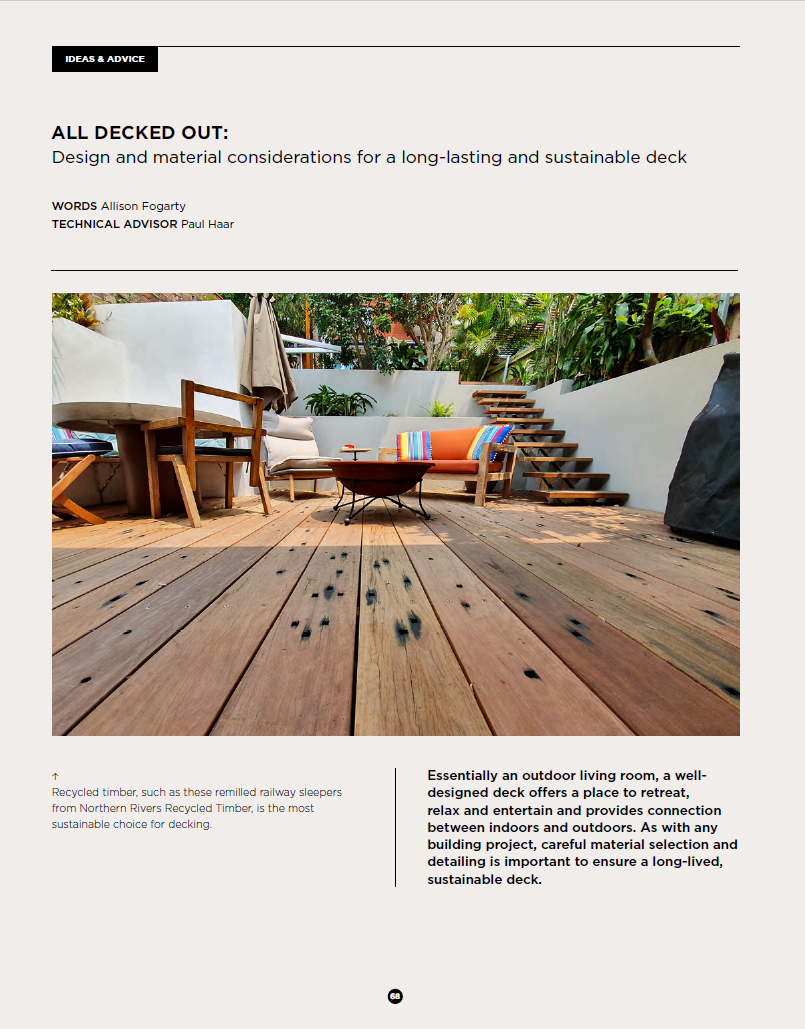
Sanctuary Magazine - All Decked Out
on Jul 15 2022
Paul Haar, our founder, and Hayden Cronin, our Manager, contributed to this decking article in the latest Sanctuary Magazine.
If you’re in Victoria, one option for salvaged timber is of course CERES Fair Wood (see ‘Fair dinkum wood’ in Sanctuary 44 for more). “We have sugar gum available at the moment, which has been salvaged from trees that were planted as farm windbreaks around Victoria. It’s a fantastic decking timber, highly durable and Class 1 for durability above and below ground,” says Hayden.
Read the full article here.
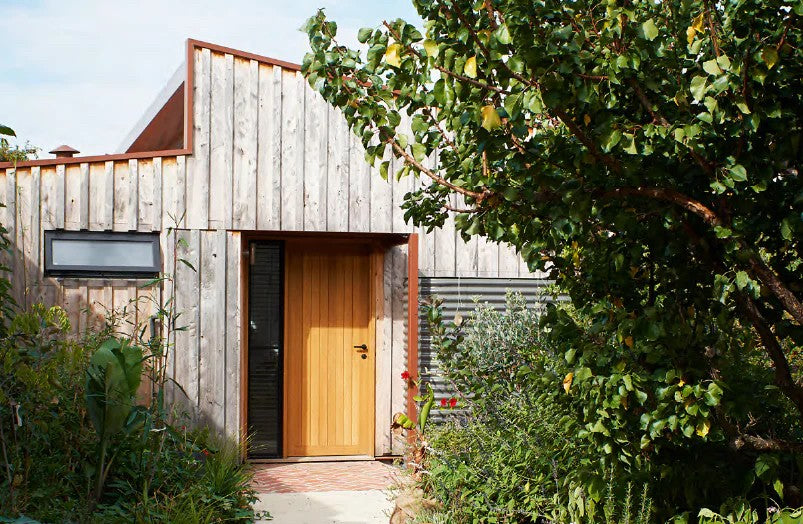
Sanctuary Magazine - Backyard Builds Family Affair
on Jul 15 2022
We are really excited to see this build by Drawing Room Architecture using our Macrocarpa Cladding product feature in the lastest issue of Sanctuary Magazine.
"Having agreed upon the design and chosen the building materials – including a simple pitched roof that gives the studio an almost agricultural shape, and reclaimed rough-sawn timber for the external cladding from CERES Fair Wood– construction started in May 2020".
Read the full article here.
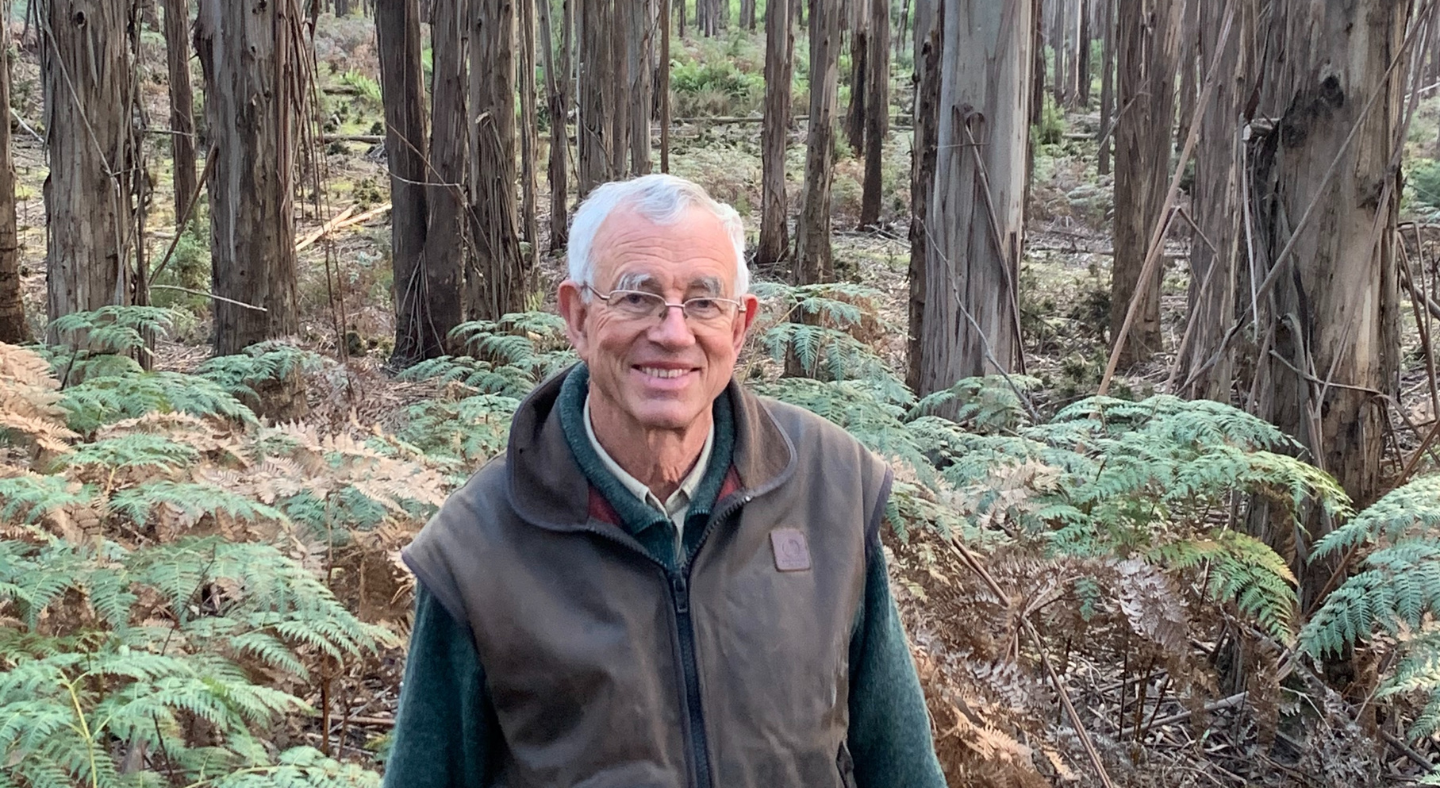
John Lord - Planting more plantations is stuck between a rock and hard place
on Jun 27 2022
"It is widely acknowledged that the only land available for more large scale plantings to help Australia provide its own timber resource is that held by the private sector, principally by the nation’s farmers.
Will the nation’s farmers in suitable climates be interested in providing parts of their farms to be planted to trees?
They should, for lots of environmental, farm economic, family succession and risk amelioration reasons. But will they do this at the present time?
My belief is no"
...
Isn’t there right now an opportunity to address the looming log shortage and at the same time transition to a more sustainable log supply? Didn’t someone say that where’s there’s chaos there’s opportunity?"
Read the full article on Timber Biz here.
John and Di Lord are tree farmers at Longford in Tasmania / lutruwita and were named National Treefarmer of the Year in 2005 and Tasmania Treefarmer of the Year in 2006.
We have been trialing some of their timber over the last 12 months to much success. We have Shining Gum lining and a number of joinery timbers in stock.
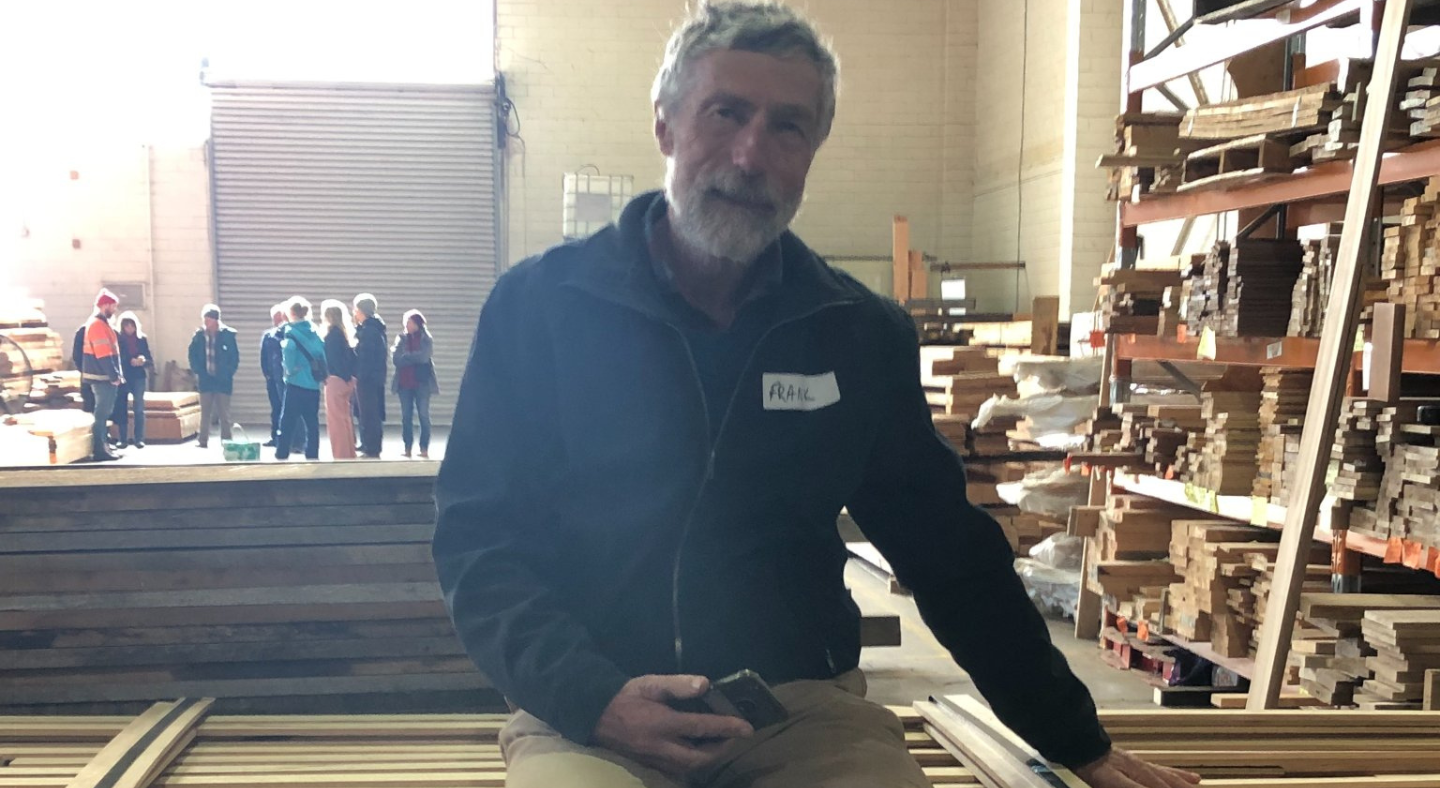
on Jun 21 2022
Words by Chris Ennis via his Fair Food Newsletter.
Winter solstice falls this Tuesday
The grey and wet days leading up to the longest night of the year are often accompanied by a sort of existential soul fog.
Similar to mould spreading across a damp bathroom ceiling the pre-solstice darkness is the perfect environment for dark introspection and a creeping kind of malaise.
To balance dark comes the light, for bathroom mould there is sugar soap and for my solstice malaise there are tree farmers.
On Wednesday Joel Geoghegan from the Bass Coast LandCare Network brought eighteen South Gippsland tree farmers to visit CERES Fair Wood.
Among this group there are people harvesting mature trees planted decades ago just as there are those whose trees will mature long after they are dead and gone.
The trees they plant will build houses and make furniture but they will also bring back birds not seen for years, they will hold water in drying soils, slow down hot winds, shade bare ground, regrow fungal internets, create rain and lock up carbon we have put up in the sky.
Agro-foresty pioneer and art-lover Rowan Reid would also posit that these trees will satisfy our deep need for beauty – that nothing makes our hearts soar higher than broken farmland regenerated with stands of swaying trees we have put back.
Outwardly the visiting tree farmers are not particularly upbeat nor are they in any way dour but there is a solidity about them - perhaps it's their ability to envision cycles of time that most of us will never be able to see.
Last Thursday I saw this vision literally being franked by Frank Hirst as he sat atop two packs of timber milled from Southern blue gum seedlings he planted on his eroded farm in Ranceby more than thirty years ago.
Check out the Southern Blue Gum cladding here.
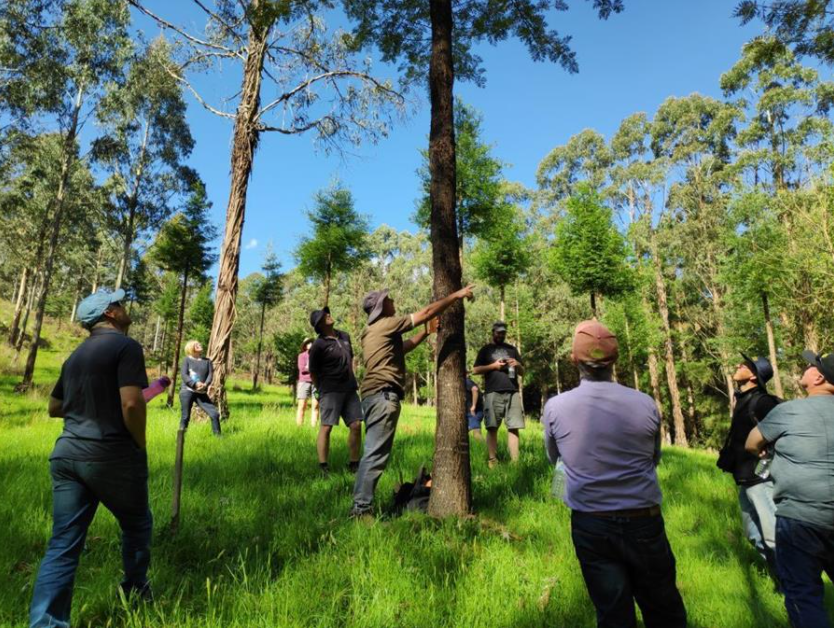
on Oct 04 2021
Part of the CERES Fair Food newlsetter series, words by Chris Ennis.
In his recent ABC Gardening Australia profile architect Paul Haar goes to a building site – he wants to talk about pine – the timber we use to build stud walls in our houses.
Paul holds up a four-by-two end-on to the camera.
Pointing out the very fine growth rings, Paul estimates this piece of wood comes from a 200-300 year old Baltic pine.
He then shows a second four-by-two, three broad growth rings indicate it’s from a 30 year old Australian Radiata pine.
To most builders there’s no difference between Baltic and Radiata pine; pine is pine is pine, they cost the same, they build stud walls and roof trusses the same.
Baltic pine sounds so wholesome; it makes me think of saunas, mid-century Danish furniture, singing along to Norwegian Wood in my bedroom when I was fourteen.
The truth is not so wholesome – the 200-300 year old Baltic pines we’re building our houses with are being cut from a fast disappearing boreal forest in Eastern Russia.
This Amazon-sized eco-system, home to Siberian tigers, is a massive carbon sink and won’t ever be replanted – once it’s gone, it’s gone.
The Radiata pine meanwhile comes from a local plantation which will be regrown after each harvest.
Learning about these two types of pine is like discovering the difference between battery hens and proper free range chickens.
My reaction is, Why don’t we know this? Why don’t they tell us this at hardware stores?
Like Baltic pine there are lots of other native timbers we use every day but don’t talk about – Merbau from South East Asian rain forests, Cumaru from South American jungles, even our own old growth Mountain Ash.
This timber cone-of-silence was what drove Paul Haar to help establish Fair Wood at CERES.
He envisioned Fair Wood talking about where our timber was coming from and then be a place that you could go and buy an ethical alternative – just like a regular hardware.
These days Fair Wood has its own warehouse, just like a regular hardware and its managers, Hayden and Pete, have been very resourceful at finding “good wood” alternatives.
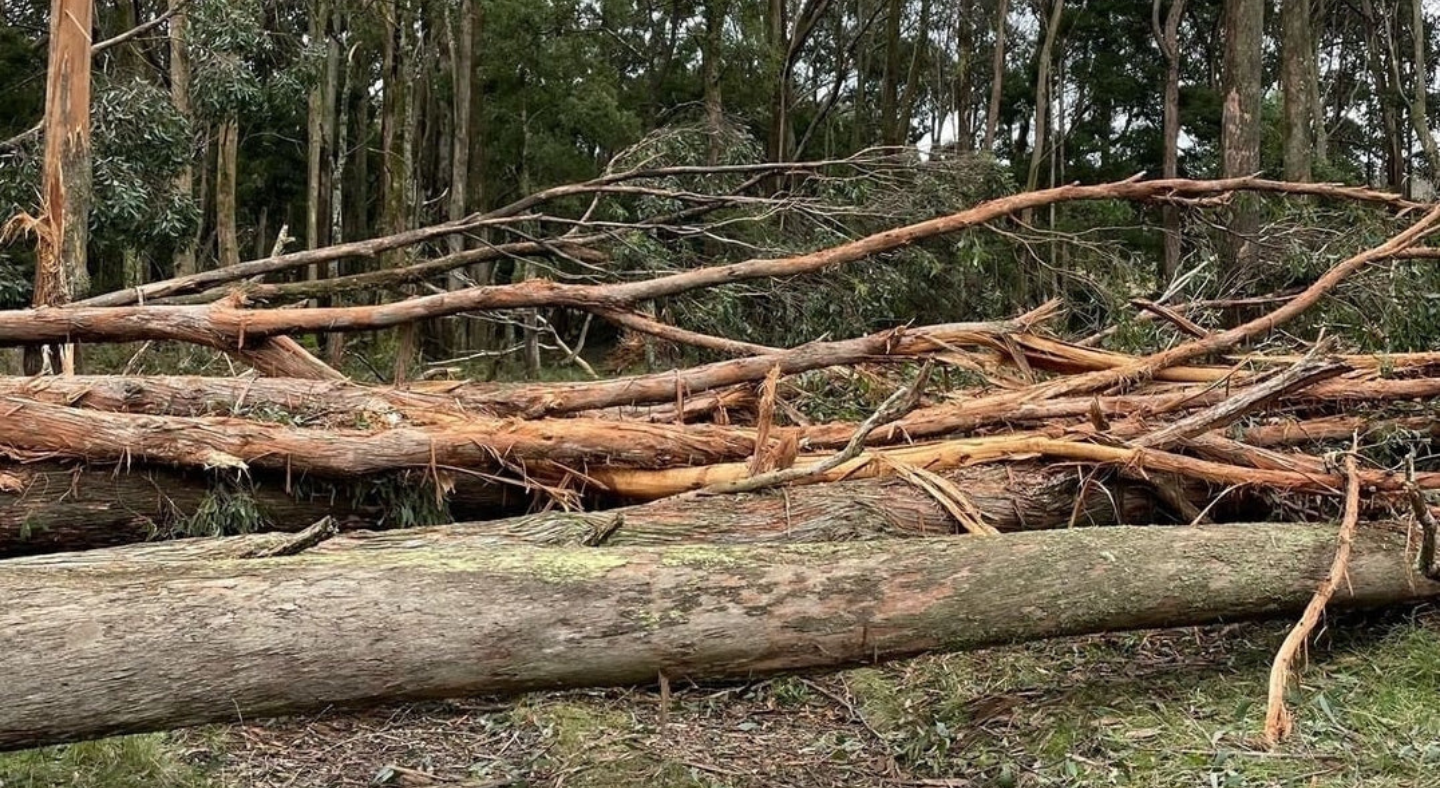
on Oct 04 2021
Part of the CERES Fair Food newlsetter series, words by Chris Ennis.
On Friday, sustainable architect and CERES Fair Wood patron, Paul Haar, was profiled in a wonderful piece on Gardening Australia.
A theme throughout Paul’s career has been the creative and thoughtful use of timber in his buildings coupled with an equally creative and thoughtful approach to sourcing wood.
One of the creative and thoughtful timber sources Paul’s introduced to Fair Wood has been milling trees that have fallen across roads or are endangering houses.
The storm that tore through Victoria a week and a half ago brought down so many mature trees that Hayden Cronin, Fair Wood’s manager, has been inundated by emails asking for help – including one from a landholder in Newbury who had lost more than 100 trees.
Offers of fallen trees to mill were already coming in after the story we did on urban sawmiller Paul McKay but since last week’s storm we are now thinking about how we can do more to save these trees from becoming firewood and mulch.
With so many trees on the ground and time against him, Hayden mused this week that if Fair Wood had a space to keep the logs he could progressively mill them through the year.
